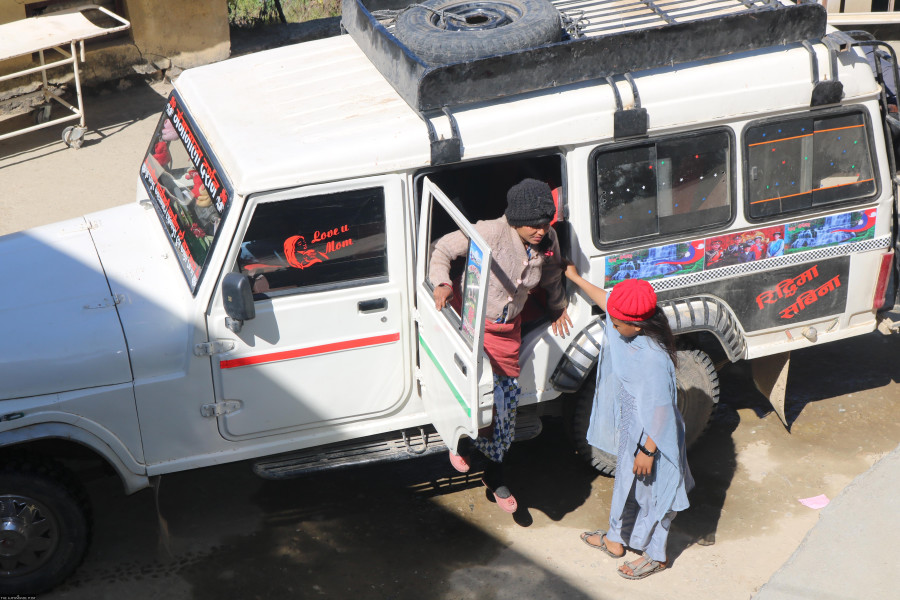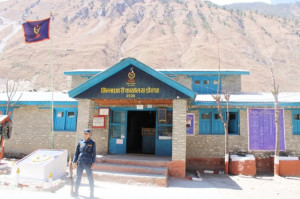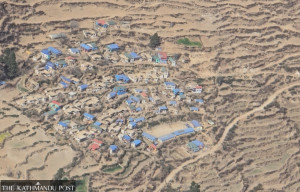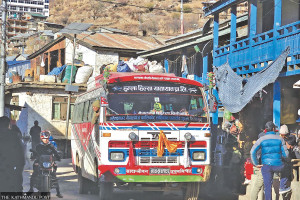Karnali Province
Contrary to their wishes, rural women in Salyan compelled to give birth at home
Lack of motorable roads makes birthing centres inaccessible to pregnant women while birthing centres closer home lack skilled health staff.
Biplab Maharjan
Two months ago, Purnima BK, a 22-year-old woman from Majhkada in Bangad Kupinde Municipality-11 gave birth at home despite her wish for an institutional birth.
“I wanted to give birth at a birthing centre, where there would be medical professionals to help me through the process,” she said. “But the ambulance did not reach my house on time. I went into labour and soon gave birth at home.”
The rural municipality has seven health posts with birthing centres but not all of them provide maternity services for a lack of skilled health staff.
BK’s post-delivery days were harrowing for her and her family since her bleeding did not stop. She was taken to Surkhet Provincial Hospital four days after her delivery.
She survived the ordeal but has yet to gain back her health, she says.
A month ago, 24-year-old Nirmala Roka from Kalagaun in Kumakh Rural Municipality-5 was taken to a local health centre by her relatives after she went into labour. The health post referred her to Salyan District Hospital as it lacked skilled health workers. Less than half an hour after her referral, she gave birth in the ambulance on her way to the hospital. She returned home after a couple of days' stay at the hospital.
Five out of the seven health posts in Bangad Kupinde Municipality have birthing centres but a lack of skilled health workers means maternity services are not available.
Contrary to their wishes of going to fully-facilitated birthing centres to give birth, numerous women in the remote villages of Salyan are forced to give birth at home because of the inaccessibility to such health posts and a lack of skilled human resources in most of these health centres.
“We have sent health workers to all the health centres but not all of them are well trained. Due to the lack of skilled manpower, pregnant women are facing difficulties getting check-ups and treatment,” said Basudev Pokhrel, health coordinator of Bangad Kupinde Municipality.
The government operates several birthing centres in the district—a total of 45 health institutions in 10 local units of the district have birthing centres. But most of these health institutions are in comparatively urban centres and unreachable for most women in the rural areas. The ones in the rural areas do not have the necessary resources to run a fully equipped birthing centre.
According to the District Health Office, the institutional delivery rate in the district is only 68 percent for the fiscal year 2021-22. The total number of pregnant women in the same year stood at 6,019.
“Three women have lost their lives in the last three years due to delays in reaching hospitals. Last year alone, the district reported 37 stillbirths mainly due to the inaccessibility to health centres and a lack of awareness,” said Thal Raj DC, coordinator of the Safe Maternity Programme at the Health Services Office in Salyan.
Although government and private health institutions in the district provide ambulance services, the lack of road penetration in rural areas means that rural women rarely get to use the service.
“My wife gave birth at home two months ago since our ward does not have a birthing centre. Our village is not connected to the road network so we don’t have access to transport services,” said Nandaram Pun of Nigalchula, Bangad Kupinde Municipality-12. “It takes almost two hours to reach the district hospital by road but the roads are only open tracks and unmotorable most of the time. Pregnant women suffer a lot during pregnancy and end up giving birth at home or on the way to the hospital.”
Thal Raj DC, coordinator of the Safe Motherhood Programme at the Health Services Office in Salyan, says that although the remote locations of the villages play a major role in keeping pregnant women away from hospitals, a lack of awareness on the importance of prenatal checkups and institutional births also contribute to the low percentage of women visiting health centres for birth.
“We have to do more to spread awareness on the availability of medical services at birthing centres to attract more women to visit health posts for the duration of their pregnancy,” said DC. “People in the villages wait until the last moment to bring pregnant women to hospitals. This puts the lives of both the mother and baby at risk. Accessibility is also a big challenge since most villages do not have transportation services or motorable roads.”
According to last year’s data of the municipality, out of 732 pregnant women, only 392 had an institutional delivery, excluding the ones who gave birth outside the district.
Pokharel, the health coordinator of Bangad Kupinde Municipality, says women in rural areas are forced to give birth in an unsafe manner because there aren’t enough birthing centres that are accessible to them.
“Even though the municipality has arranged free ambulance services for pregnant women, the service remains underutilised because of a lack of good roads,” said Pokharel.
Meanwhile, Prabhat Shrestha, health coordinator of Tribeni Rural Municipality, said that the number of home births in the local unit has decreased in the past year.
“Despite transportation challenges, families in the villages reach the nearest birthing centres for childbirth. Only seven people gave birth at home in Tribeni this fiscal year. It is good progress,” Shrestha said.




 13.98°C Kathmandu
13.98°C Kathmandu














